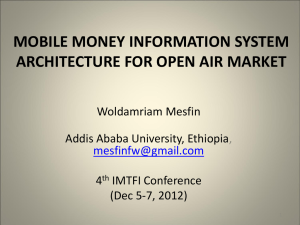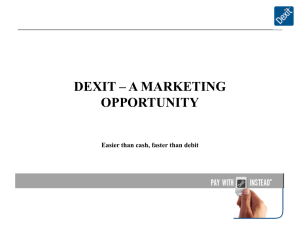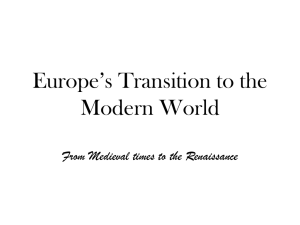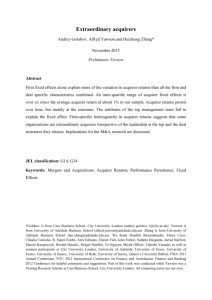The Regulation of Payment Cards - Initiative for Public Policy Analysis
advertisement
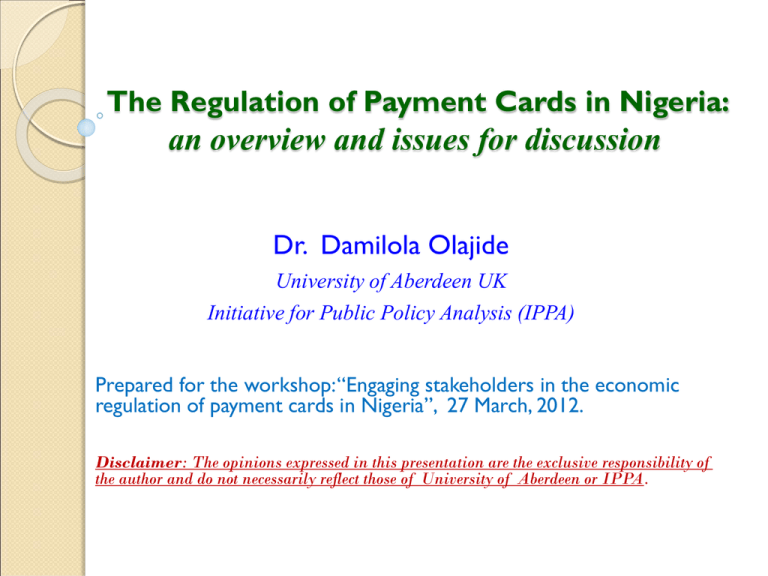
The Regulation of Payment Cards in Nigeria: an overview and issues for discussion Dr. Damilola Olajide University of Aberdeen UK Initiative for Public Policy Analysis (IPPA) Prepared for the workshop: “Engaging stakeholders in the economic regulation of payment cards in Nigeria”, 27 March, 2012. Disclaimer: The opinions expressed in this presentation are the exclusive responsibility of the author and do not necessarily reflect those of University of Aberdeen or IPPA. Objectives To provide an overview of the regulation of the payment cards in Nigeria. This will allow us to identify issues for further discussion in the stakeholder engagement process. We will examine current practice and evidence of distortions: Market structure: Competitiveness, concentration, etc. Market imbalances: acquiring rules and costs, fees structure, etc. Some lessons from previous presentations International experience with regulation: ◦ Payment cards market is one of the most regulated industry E.g. Australia, USA, UK, Hong Kong, Brazil, Mexico, Canada. ◦ Targets of regulation include: Interchange fees Merchant surcharging rules Entry barriers, etc. Evolution of payment cards in Nigeria: ◦ High initial adoption level has not been sustained overtime. ◦ Usage and adoption rates have been significantly low due to insufficient information and the largely unbanked segment of the population. ◦ Little headway with credit card channel. Emerging question What sort of public intervention (economic regulation) will improve adoption of card usage by consumers and card adoption by merchants? To address this questions we need to understand: ◦ How the payment cards market works ◦ Evidence of market failures (distortions, and imbalances) in current practice. The economics of payment cards market relates to: ◦ an understanding of how the market works, ◦ the relevant type of markets, and ◦ the interrelationships between parties in a payment system. Analysis emerging are used to discuss the economic regulation of the industry. The payment cards market as two-sided market Cardholders (consumers) and Merchants (POS) represent two different demand structures to be satisfied at the same time. One side of the market consists of cardholders and card issuers, the other side consists of merchants and acquirer. The relationships between the two markets are interdependent . The demand from one side is dependent on the demand of the other side (externality). The card networks (card schemes/switches) play an important intermediating role of balancing the two sides of the market, through which each side have access to each other’s market. The balancing act creates economic value by providing incentive to facilitate and encourage participation of both sides of the market. An illustration (E.g. N100 transaction) Cardholder Uses card to purchase good/service (N100) Submits transaction for authorisation Levies card charges or gives rewards Issuer bills cardholder (N100) Issuer Merchant Card Network Merchant pays fees to acquirer (N0.50) Merchant receives N98.25 Acquirer pays interchange fees to issuer (N1.25) Acquirer Issuer approves transaction & transfers N98.75 via network to Acquirer Card network brings issuing and acquiring markets together for a fee. Importance of interchange fees (IF) • Why does the interchange fee generate so much issue in the regulation of a payment cards market? • IF is not a price per se, but a mechanism for balancing the two sides of the market, in such a way that: Issuers are able to recoup cost without imposing higher fees on the cardholder, Merchants compensate issuers for the costs incurred in providing the payment service. The IF should be set so as to be able to balance the costs of provision with the benefits of usage to the merchant. The economic role of IF is to shift costs between issuers and merchant acquirers, which enhances the value of the payment system. Results from the literature on IF regulation (i) IF is a balancing mechanism, not a price per se. IF is efficient when the total transaction demand for card services (determined jointly by cardholder and merchant), is equal to the total transaction costs of providing those services by both the issuer and the acquirer. Merchants operating at the same level playing field (competitive) is required for IF to be social optimal, even if issuer and acquirer exercise market power. If merchants in different industries receive different benefits (e.g. due to transaction volume or value), a change in IF will generate a trade-off between cardholder benefits and merchant acceptance. Some merchants may refuse card payments. IF is neutral, irrespective of whether merchant, issuer or acquirer has market power. The Nigerian model (CBN 2011 Guidelines) Merchant Cardholder NCS PTSA Issuer PTSPs Acquirer Nigerian model deviates significantly at the acquiring side of the market, but offers potential benefits, but at extra costs to merchants. Table 1: Distribution of card products and card product concentration No. of banks CR4 b CR2 21 43.5 0.272 53 19 0.509 0.321 Credit cards 33 9 0.606 0.364 Naira Denom. 43 10 0.605 0.326 $' Denominated 32 20 0.406 0.281 Dual currency ($ & N) 15 6 0.867 0.667 No. of card offering products a products All 92 Debit cards Note: a Figures compiled from information on card products available on bank websites as at 31 July, 2011; b CR4=share of 4 banks in total no. of cards. This can be multiplied by 100 to give percentage (%) The market structure indicators Issuing market is characterised by horizontal product differentiation. Same card offered in different features: ◦ Benefits issuing banks, improve quality and delivery of service, but may create entry barrier to non-bank issuers. ◦ May bias cardholder perception of card products. ◦ May contain hidden costs to customers. Evidence of competition through product differentiation, (rather than prices?) Evidence of market concentration is weak generally, but concentration is observed for credit cards and dual currency cards are concentrated. Credit card is the most productive of all cards, but least provided. Acquiring side of the market is characterised by duplication of functions. Same banks control both sides of the market. Payment card imbalances From a two-sided market perspective there should be: ◦ correspondence between card usage and POS. The ratio of cards per POS is very high. ◦ correspondence between both market sides. The acquiring side of the market is distorted. Card acceptance service stakeholders Acquirers: banks & non financial entities to deploy POS terminals. Payment Terminal Service Providers (PTSP): deploy, maintain and support POS terminals. Payment Terminal Service Aggregator (PTSA): comprises NIBSS owned by all banks & CBN. Routes transactions on terminal to acquirer. POS terminal owners (PTOs): banks, merchants, acquirers, PTSA, PTSPs allowed to own their terminals. Card issuers: restricted to deposit taking banks. Required to provide sufficient information to card holders, e.g. limits, fees and charges. Merchants: No-surcharge rule. Accept all cards issued in Nigeria Cardholders: Allowed to opt-out of a card contract without a penalty. Card associations/schemes: comprises of local switches (e.g. Interswitch) and international card networks (VISA and MasterCard). Switching companies: provide payment infrastructure and interconnect issuing and acquiring banks. Can own cards. Structure of fees and charges Fees: Interchange fee plus fees paid by merchants to acquirer? Agreed between providers and banks 1.25% of total transaction value or max. N2, 000. Large merchants such as airlines and hotels face different limits. Stakeholder Distribution of fees/charges (%) Issuer 30.0 Acquirer 32.5 Payment terminal owner 25.0 Local switch 5.0 Payment TSA 7.5 Different fees structure applies to foreign currency dominated transactions. Distortions (i): Acquiring side of the market Acquire through PTSP, connect through PTSA. Agency problem in the terminal ownership and deployment. Bank, acquirer, merchants, PTSA, PTSPs can own terminal, but only PTSP can deploy and maintain. Restricted entry into PTSP. Anyone having relationship with the issuing side of the market is excluded. Acquiring costs is largely dependent on the competitiveness of the PTSPs. Six PTSPs and restricted entry raises concern for collusive pricing. Evidence of duplication of processes and functions, which may increase costs to end-users (consumers and merchants), ultimately affecting usage and adoption. Distortions (ii): issuing side of the market The issuing side of the market is relatively less distorted: Card associations/schemes are forbidden from undertaking activities that are collusive, anti-competitive, etc., There is functioning no antitrust laws or a fully independent antitrust agency to determine these behaviour when the need arises. Switches can only interconnect issuing and acquiring banks through the PTSA and then National Central Switch (NCS). Duplication of interconnectivity function. May raise costs to issuers and ultimately to end-users( cardholders and merchants). Distortions (iii): Fees structure The intermediating role of fees is unclear from the fees structure. The role of card networks in setting the fees is limited. The fees structure does not balance the market. Merchants incur additional cost of terminal acquisition provided outside the market framework. Where the issuer and acquire are the same as in most banks, then the share of the fees is 62.5%, and 87.5% if also owns POS terminal. Distortions (iii): Fees structure (ctd) Existing rule price discriminates between small retail merchants and large merchants. ◦ The max. transaction for small retail merchants is N160,000 (i.e. 2000/0.0125), but large merchants such as airlines can negotiate with acquiring banks. ◦ Potential retail merchants with sales over this limit are effectively constrained. All potential merchants should be allowed to negotiate limits with their acquiring banks based on their type of business. Summary The Nigerian payment cards market is undergoing rapid development, making certain distortions and imbalances imperative. Evidence of concentration is weak, but some banks dominate both sides of the market. Important distortions include: ◦ Low POS adoption, implicitly constrained in the acquiring side. ◦ Debit cards are largely used at ATMs rather than for purchases at POS. Important imbalances include: Fee structure disfavour retail merchants. Concluding remarks (i) At present, setting fees by the Bankers Committee is an outcome of a bargaining process rather than the ‘balancing act’. This will always raise suspicion. Regulating the IF will be complex and undesirable, but its determination should be left to those who function to balance both sides of the market. If networks set the interchange fees, a removal of no-surcharge rule can achieve the dual goal of enhancing card usage and POS adoption. An alternative to the removal of no-surcharge rule is to provide incentive to potential merchants (e.g. tax relief) equal to the additional costs imposed by the acquiring side of the market. Concluding remarks (ii) It is important to eliminate barriers to entry: e.g. PTSPs are only 6 serving the entire market. A well functioning Credit Agencies will enhance credit card usage. Credit card offers the greatest benefit to the population. The proposed Ombudsman bill is not fully independent as it is industry specific. Need for a fully independent Federal Anti-trust and Competition Commission: to determine evidence of anticompetitive behaviour. Complements the Ombudsman: ◦ Comprise experts in anti-trust laws and industrial economics, not politicians. E.g. Office of Fair Trading UK is different from the Financial Ombudsman. Some questions for discussion Which of the following changes in current practice will you recommend in order to enhance POS adoption by potential merchants? (i) (ii) (iii) (iv) (v) Merchants be allowed to surcharge a small fee on card transactions. An incentive such as a tax relief for potential merchants. Reduce the proportion of fees in total value of a transaction from 1.25% to 1%. Payment Terminal Service Providers and Payment Terminal Service should merge into a single entity and operate under NIBSS. The Bankers Committee should leave setting of fees to networks. The remaining questions are provided to you directly. Thank you

